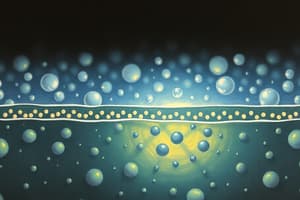Podcast
Questions and Answers
What type of transport requires energy to move substances across the cell membrane?
What type of transport requires energy to move substances across the cell membrane?
- Simple Diffusion
- Passive Transport
- Active Transport (correct)
- Facilitated Diffusion
Integral proteins are only found on the surface of the cell membrane.
Integral proteins are only found on the surface of the cell membrane.
False (B)
What are glycoproteins and glycolipids?
What are glycoproteins and glycolipids?
Glycoproteins are proteins with carbohydrates attached, while glycolipids are lipids with carbohydrates attached.
Cholesterol acts as a membrane __________ agent by helping to maintain fluidity.
Cholesterol acts as a membrane __________ agent by helping to maintain fluidity.
Match the following functions of peripheral proteins:
Match the following functions of peripheral proteins:
What is the primary function of the cell membrane?
What is the primary function of the cell membrane?
The cell membrane is completely permeable, allowing all substances to pass through.
The cell membrane is completely permeable, allowing all substances to pass through.
What are the two different ends of a phospholipid molecule called?
What are the two different ends of a phospholipid molecule called?
The cell membrane is described as a __________ because it is composed of various parts.
The cell membrane is described as a __________ because it is composed of various parts.
Match the following components of the cell membrane with their respective roles:
Match the following components of the cell membrane with their respective roles:
Flashcards
What is the function of the cell membrane?
What is the function of the cell membrane?
The cell membrane controls what enters and leaves the cell, just like a gatekeeper.
What is the cell membrane's permeability?
What is the cell membrane's permeability?
The cell membrane is a selectively permeable membrane because it allows some substances to pass through, while others cannot.
What is the structure of the phospholipid bilayer?
What is the structure of the phospholipid bilayer?
The cell membrane is a double layer of phospholipid molecules, with hydrophilic heads facing outwards and hydrophobic tails facing inwards.
Integral Proteins
Integral Proteins
Signup and view all the flashcards
Peripheral Proteins
Peripheral Proteins
Signup and view all the flashcards
What is the fluid mosaic model?
What is the fluid mosaic model?
Signup and view all the flashcards
What is the role of proteins in the cell membrane?
What is the role of proteins in the cell membrane?
Signup and view all the flashcards
Channel Protein
Channel Protein
Signup and view all the flashcards
Carrier Protein
Carrier Protein
Signup and view all the flashcards
Cholesterol
Cholesterol
Signup and view all the flashcards
Study Notes
Cell Membrane Overview
- The cell membrane is also known as the plasma membrane.
- It's a gatekeeper, separating the cell's interior from the external environment.
- It controls the movement of materials into and out of the cell.
- The membrane is semi-permeable, allowing only some substances to pass through.
Cell Membrane Composition
- The cell membrane is composed of a phospholipid bilayer.
- Phospholipids have hydrophilic heads and hydrophobic tails.
- Hydrophilic heads are attracted to water, while hydrophobic tails repel water.
- The bilayer structure arranges the tails inwards, away from the water inside and outside the cell.
- Only small, fat-soluble molecules can pass directly through the phospholipid bilayer.
Proteins in the Cell Membrane
- Proteins act like doorways within the membrane.
- They allow larger or polar molecules to pass through, which cannot pass through the phospholipid bilayer independently.
- Membrane proteins can be either integral or peripheral.
- Integral proteins are embedded within the phospholipid bilayer and frequently span the entire membrane. They assist in transporting large and polar molecules.
- Peripheral proteins are located on the surface of the bilayer. They can assist in cell signaling, acting as enzymes, or influencing shape and structure.
- Integral proteins come in two types: Carrier and Channel
- Channel proteins are essentially open tubes that create pathways allowing molecules to pass through passively.
- Carrier proteins "pick up" molecules and carry them across the membrane—this process often requires energy (active transport).
Carbohydrates in the Cell Membrane
- Carbohydrate chains adhere to the membrane's outer surface.
- Carbohydrates help cells recognize other cells and aid in cell adherence.
- Glycoproteins are proteins with attached carbohydrates.
- Glycolipids are lipids with attached carbohydrates.
Cholesterol in the Cell Membrane
- Cholesterol is a steroid embedded within the phospholipid bilayer.
- It helps maintain membrane fluidity, balancing it at various temperatures.
- At high temperatures, cholesterol helps decrease fluidity.
- At low temperatures, cholesterol helps increase fluidity.
- Cholesterol acts as a "membrane antifreeze agent".
Fluid Mosaic Model
- The cell membrane is fluid because of its components (like lipids and proteins) that can move laterally within the membrane.
- The membrane's dynamic behavior is likened to a mosaic, composed of various parts.
Studying That Suits You
Use AI to generate personalized quizzes and flashcards to suit your learning preferences.
Related Documents
Description
Explore the fundamental aspects of the cell membrane, also known as the plasma membrane. This quiz covers its role as a gatekeeper, its phospholipid bilayer structure, and the function of proteins within the membrane. Test your understanding of the cell membrane's properties and composition.




